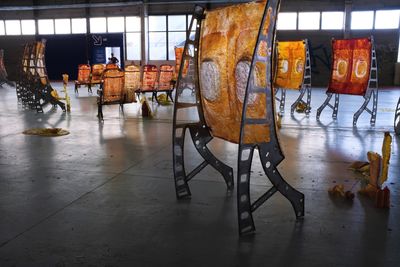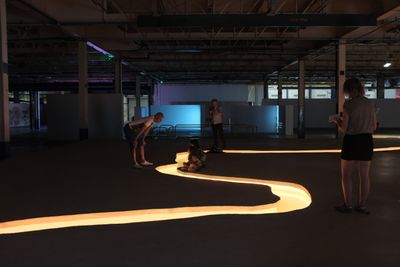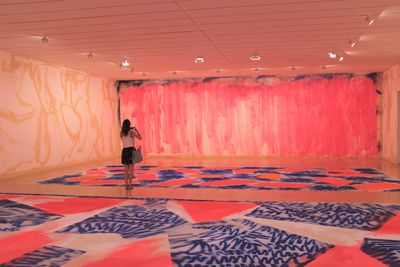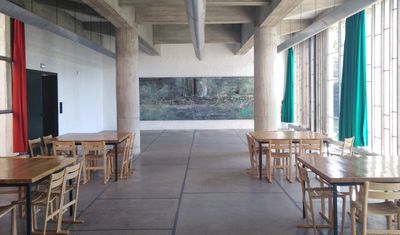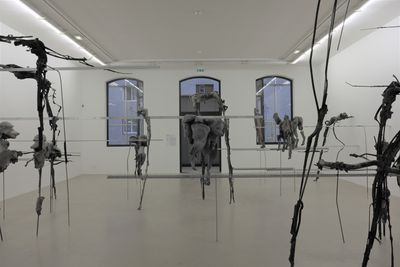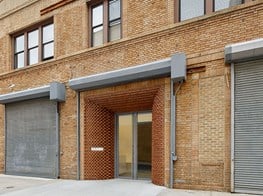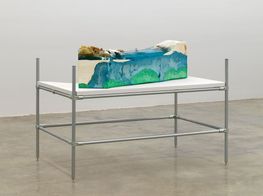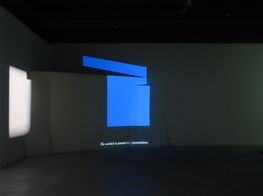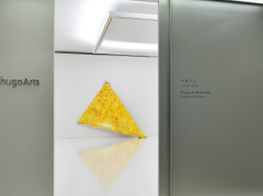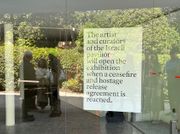Lyon Biennale 2019: The Art of Dispersal

Petrit Halilaj, Shkrepëtima (2019). Exhibition view: Là où les eaux se mêlent, 15th Lyon Biennale, Fagor Factory, Lyon (18 September 2019–5 January 2020). Photo: Christopher Taylor.
'The places where water comes together with other water. Those places stand out in my mind like holy places.' This excerpt from a poem by American writer Raymond Carver is the somewhat florid departure for Là où les eaux se mêlent, the 15th Lyon Biennale (18 September 2019–5 January 2019)—a materially rich exhibition of works by around 50 artists from across the globe that are interspersed across two venues: Fagor Factory and the Musée d'art contemporain de Lyon.
Within the shell of Fagor Factory, an ex-appliance manufacturer that fell into disuse in 2015, the exhibition's seven curators from Palais de Tokyo (Adélaïde Blanc, Daria de Beauvais, Yoann Gourmel, Matthieu Lelièvre, Vittoria Matarrese, Claire Moulène, and Hugo Vitrani) favoured an open display, with large-scale installations spread across the 29,000-square-metre space. Without any visual directions or buffers aided by walls or barriers, the initial experience of the first hall is overwhelming, with form, colour, and sound speckling the industrial space. Given time, this spatial freedom allows for interesting connections between artworks and the building's industrial past to emerge; even if the view of the factory's old refectory, where 30-euro brunch is offered on Sundays, calls attention to gnawing gentrification.
To the far left of the first hall, Khalil El Ghrib presents an untitled installation of masses of quicklime bound by silk threads beneath the frame of an old assembly line, presented in varied colours to reference the changing seasons. The work references Lyon's history as an important site for the processing of silk and of revolts by the canuts, or silk workers in 1831 and 1834, some of the first working-class uprisings to occur in early capitalist development, while recalling the building's most recent function and collapse.
Many of the works on view have an abject, residual quality, occasionally amounting to the aftermath of collision and disaster, like Rebecca Ackroyd's crash-site installation Singed Lids (2019), made from red-orange wax of a deconstructed airplane and its seats interspersed with decapitated limbs. Making use of the high ceiling to the centre of this hall is Tetzahuitl (2019) by Fernando Palma Rodriguez—43 children's dresses that periodically rise to the ceiling through a robotic system that reverberates throughout the hall with a mechanic ghostliness.
At sites where human existence ceases to exist or collapses, nature takes the lead—a notion that is explored in a number of works that allow the exhibition to come full circle, from human automation, to technology, and back to nature. At the entrance of the first hall, for instance, Ronciers (2019) by Jean-Marie Appriou is a collection of immense silver bramble branches arranged in loose, scrawling clumps—a thorny reminder of humankind's place in the world.
The exhibition descends into darkness in the second hall, which resembles a cave illuminated by phosphorescence. In Minouk Lim's Si tu me vois, je ne te vois pas (2019), a thin, curving creek filled with orange light and a giant silver pinball that floats across its surface; while off to the right, a thin mass of orange soap has oozed and hardened across the floor—the result of Nicolas Momein's Bouilleur de savon (2019), for which the artist extracted the essence for soap from various sources in Grand Parc Miribel Jaunage, a park on the outskirts of Lyon. Chemical transmutations are also visible in Bianca Bondi's installation The sacred spring and necessary reservoirs (2019), in which a kitchen has been covered in a sparkling, blue-tinged salt crust.
A theme of blue continues with nine video projections by Hong Kong-born Taiwan-based artist Lee Kit, whose haphazardly assembled projections, often with cord and projector self-consciously on display, project videos of mundane moments of the everyday that make up Sketching the Weight of Idleness and Guiltiness (2019). Fluffy white pillows on a bed, or a slice of bread rotating in a microwave to the song 'Oh, I Buried You Today' by Danish indie rock duo The Raveonettes, stand for moments that come and go in a day, but that have the dual potential of being sites of personal reflection and regeneration. These projections add a dimension to this show that emphasises moments of lapse, where new ideas, feelings, and other physical or mental states might come into being.
Installations seem to expand further in halls three and four, with Mire Lee's installation Saboteurs (2019) taking up a large portion of the former. A series of squirming mechanics and chains rest in pools of white liquid and hang from the ceiling, wrapped in the hardened substance. To the back of this same hall, Thomas Feuerstein's mad scientist installation, Prometheus Delivered (2017–2019) is a scramble of black wires that feed in and out of various tubes and a central sculpture, a replica of Prometheus Bound (1762) by Nicolas Sébastien Adam that is being slowly decomposed by chemolithoautotrophic bacteria.
Where a diversity and abundance of installations creates exciting moments of discovery in the first three halls, the ever-expanding works provide less intimate sites of encounter in the fourth and fifth. Installations such as Sam Keogh's great Knotworm (2019), a huge hunk of a tunnel boring machine, and Holly Hendry's air conditioning pipes stuffed with plaster and jesmonite, Deep Soil Thrombosis (2019), are somewhat lost to the industrial surroundings.
The exhibition fizzles out in the vast and almost empty final hall—a sentiment that was exacerbated at the biennale's second venue at the other side of the city, the Musée d'art contemporain de Lyon, where the walls of five rooms are covered in pink and blue scrawls by Renée Levi (Mia, Moira, Mi, each 2019), while two floors comprise Mammalian Fantasies (2017–2019) by Daniel Dewar & Grégory Gicquel—an 'imaginary museum' of sparsely installed solid oak sculptures bedecked in protruding limbs, snails, pigs, and more; a bewildering display that offers little connection to the exhibition at Fagor Factory.
While the two main exhibition sites are located north and south of the city, eight associated exhibitions complement the biennale's very broad vista, extending 34 kilometres south of Lyon in Vienne at La Halle des Bouchers, and 33 kilometres northwest at the Couvent de la Tourette in L'Arbresle. At the Couvent de la Tourette, installations, paintings, sculptures, and window displays by Anselm Kiefer are curated by Friar Marc Chaveau across the Le Corbusier-designed convent, combining religious life with art and architecture—a holiness as recalled by Raymond Carver's poem in relation to the merging of worlds.
In Vienne, La Halle des Bouchers presents The Worldly Cave (2017) by Chinese film director Zhou Tao (14 September–24 November 2019), which captures Hakka communities in the South Korean port of Incheon, the Spanish Island of Menorca, and the Sonoran Desert in the southwestern United States. Carefully cropped scenes zoom in on dreamlike environments, including figures fishing in a muddy plane punctured with pools of water reflecting orange light, and the moonlit back of a cow rummaging amongst abandoned, industrial-sized washing machines. With no plot or dialogue, the film visualises an unsettling disconnect in the age of the Anthropocene.
In northeast Lyon, the Institut d'art contemporain de Villeurbanne presents Young International Artists (18 September 2019–5 January 2020)—a collection of works by ten emerging artists, beginning with Giulia Cenci's installation Mud (2019) of found objects and mouldings of human and animal body fragments arranged on thin metal structures throughout the room, creating a chaotic and fragmentary landscape.
An excerpt from Paul Auster's dystopian novel, In the Country of Last Things (1987), accompanies the installation: 'There are pieces of this and pieces of that, but none of it fits together. And yet, very strangely, at the limit of all this chaos, everything begins to fuse again.' It is a quote that relates to the fragmentary nature of this entire exhibition, which offers a crossroads of artworks and sites, sometimes appearing unrelated, but offering new channels of thought. In times of uncertainty, however, dispersal can exacerbate the unknown. —[O]


